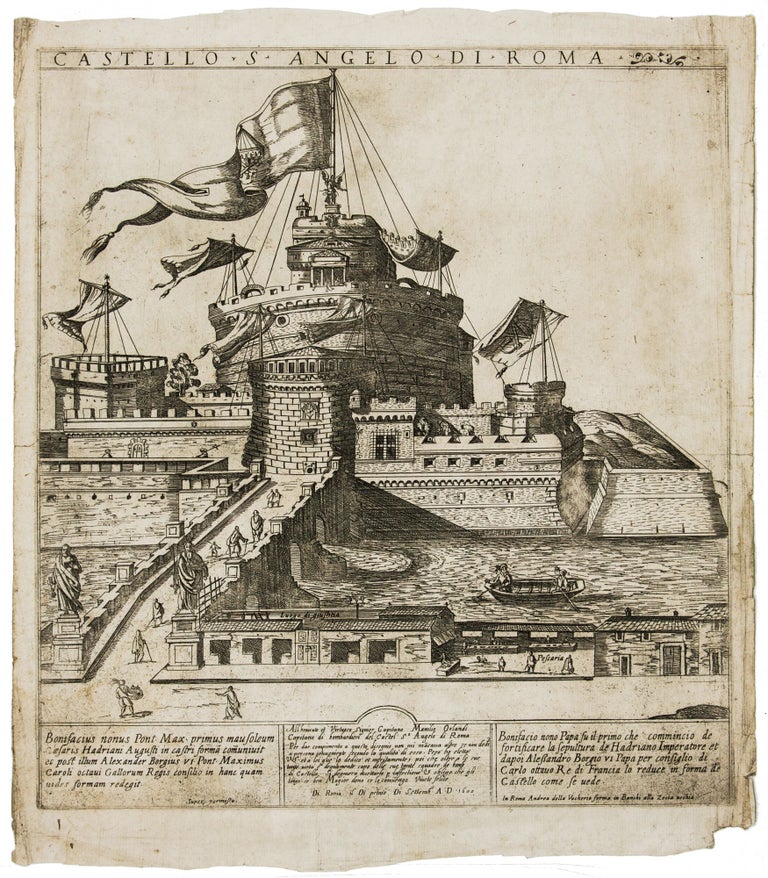
Castello S. Angelo di Roma.
Folio [42.0 x 38.5], (1) single-sheet etching. Edge wear, minor soiling generally outside the platemark, folds visible on verso. A fine strike. Very rare separately issued view of Castel Sant’Angelo in Rome, etched by Giovanni Maggi (1566-1618) and printed in 1600 by Andrea Vaccari (d. 1627) in honor of a certain Manilio Orlandi (fl. c. 1550s-c. 1602), captain of munitions (capitano di bombardieri) at Castel Sant’Angelo. The etching is unusual among printed Roman vedute of the time in that its apparent genesis was as a personal or professional piece, as opposed to a print conceived solely to appeal to the taste of pilgrims or tourists to Rome. Andrea Vaccari’s stall at the Zecca Vecchia, a stone’s throw from Castel Sant’Angelo, would have afforded the printer precisely the view of the monument seen here. The relationship between Orlandi, Maggi and Vaccari must remain a matter of speculation. Michael Bury discusses the etching in his excellent The Print in Italy 1550-1620 in a passage worth quoting in full: “The Mausoleum of the Emperor Hadrian was, as the inscription [in Latin and in Italian] in the lower margin tells us, converted into a papal fortress in the Middle Ages. The great round tower of Pope Alexander VI (1492-1503) controlled the important Tiber crossing represented by the Ponte Sant’Angelo and guarded the entrance to the Borgo, the area of the city between St. Peter’s and the river. This was probably the plate listed in the Vaccari stocklist of 1614: ‘Castel di S. Angelo come si vede hoggidi, intagliato da Gio. Maggio’ (Ehrle, 1908, p. 62, l. 291). Lorenzo Vaccari had been a significant competitor of Lafreri in Rome in the 1570s. His sons Andrea and Michelangelo continued the family business from their shop ‘at the sign of the golden Palm’ (‘all’insegna della Palma d’Oro’) in the via de’ Banchi Nuovi, opposite San Giuliano in Banchi at Monte Giordano. Compared to earlier comparable material representing monuments of ancient and modern Rome, this is a rather crude and perfunctory performance. It fits with the relative informality of what others at the time were publishing, such as the topographical etchings issued by Nicholas van Aelst. But although curiously isolated against a blank background and with a strong element of fantasy in the enormously exaggerated size of the papal banners flying from the towers, this does record rather accurately the appearance of the fortress, the bridge and the piazza del Ponte. The view of the fish market (Pescaria), the shops and especially of the place of execution (Luogo di giustitia) with its display of severed heads, provides a rare opportunity to see something of what these less imposing aspects of Roman life looked like” (M. Bury, pp. 140-1, no. 88). In 1559 Manilio Orlandi took over the position of head of munitions (primarius bombarderiorum) from his father, Giulio, a man who likely had learned the trade under Vannoccio Biringuccio (c. 1480-1539), today famed for his De la Pirotechnia (1540), the first printed book on metallurgy (see P. Pagliucchi, p. 397). Giovanni Maggi is best known for his 1603 map of Rome, his Libro di tutte le guglie (1600) on the obelisks of Rome, and his viewbook Ornamenti delle fabbriche antiche e moderne dell’alma citta di Roma (1600). The Ornamenti includes a much simplified version of this Castel Sant’Angelo etching (without the reference to Orlandi), which would seem to confirm the attribution to Maggi suggested in the 1614 stocklist of Andrea and Michelangelo Vaccari mentioned in the above quote by Bury. The dedication to Manilio Orlandi reads: “All’honorato et Virtuoso Signior Capitano Manilio Orlandi / Capitano di bombardieri del Castel S.o Angelo di Roma / Per dar compimento a questo disegnio non mi ma(n)cava altro se non dedi(carlo) / a persona conveniente secondo la qualità di esso. Però ho eletto / V.S. et a lei glie lo dedico et meritamente; poi che oltre a le sue / tante virtu e degnamente capo delle sue tante squadre de bomb(ardieri) / di Castello, Si degnerà accettarlo p(er) laffectione et obligo che gli / tengo se ben Magior dono se le convengo. Vivete felice / Di Roma il Di primo Di Settemb(re). A.D.1600.” OCLC and KVK locate examples of the etching at Columbia, Österreichischen Nationalbibliothek, and British Library (trimmed, with title missing at top). * M. Bury, The Print in Italy 1550-1620, pp. 140-1, no. 88; F. Ehrle, Roma prima di Sisto V: la pianta Dupérac-Lafréry del 1577, p. 62, l. 291; P. Pagliucchi, “I castellani del Castel. S. Angelo di Roma,” Miscellanea di storia e cultura ecclesiastica, vol. 5, no 4 (1907), pp. 389-412.
Price: $2,250.00
